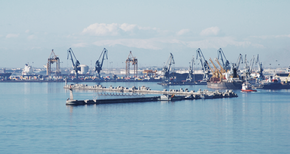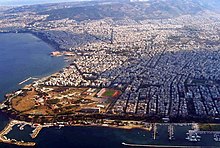Thessaloniki port
| Thessaloniki port | |||
|---|---|---|---|
| Data | |||
| UN / LOCODE | GR SKG | ||
| operator | Thessaloniki Port Authority SA and others | ||
| opening | Antiquity, (316 BC ) | ||
| Port type | Protective and free port | ||
| Total area of the port | 1.5 million m² | ||
| Throughput | 16 million t (2008) | ||
| website | www.THPA.gr | ||
| Geographic information | |||
| place | Thessaloniki | ||
| republic | Greece | ||
| Country | Greece | ||
| Port of Thessaloniki from the east (2009) | |||
| Coordinates | 40 ° 38 '0 " N , 22 ° 55' 57" E | ||
|
|||
The port of Thessaloniki ( Greek Λιμάνι της Θεσσαλονίκης Limani tis Thessalonikis ) is the port and industrial area of the city of Thessaloniki , the capital of the Greek region of Central Macedonia . In terms of area, it is the largest Greek port and the most important free port for the southern Balkans .
geography
The port of Thessaloniki is located in a sheltered bay at the northeasternmost point of the Thermaic Gulf on the Mediterranean . The approximately 150 hectare harbor and industrial area is located immediately west of the historic city center. The old train station borders Thessaloniki to the north and the Gallikos flows into the Aegean Sea five kilometers to the west .
The area is divided into five main areas. In the far west, and furthest from the city center, is the free port with the oil and chemical port, to the west of which are the container terminals. Further east are the piers for bulk and bulk goods. These parts of the port are partly equipped with two and three trains, except for the quays, with standard-gauge rail connections of the port railway and have a connection to the OSE rail network via the old Thessaloniki train station .
The eastern port area is mainly reserved for commercial passenger shipping , ferries , sightseeing and cruise ships . Only urgent scheduled freight is handled there, for example (frozen) refrigerated goods. There is only a rail connection on the western quay. In the center is the imposing building of the port administration with the passenger handling and in the western area tourist facilities such as museums, public transport and restaurants dominate.
In front of the port facilities with a total of 6,200 m pier lengths are two 1.5 km long breakwaters , so that normally only a maximum of 0.7 meters of waves and tidal range have to be expected in the port basin .
To the east of the harbor basin there are outer areas and the one kilometer long promenade Leoforos Nikis with the landmark of Thessaloniki, the White Tower from the 15th century.
Two kilometers south of it is the separate marina with its own adapted infrastructure. A little further south, on the southwestern tip of the Karabounaki peninsula, in the independent municipality of Kalamaria , which has merged with Thessaloniki in the north, are the marinas . They are used exclusively for recreational shipping and tourist purposes and are meaningless for commercial large-scale shipping.
history
Already in the Neolithic and the Copper Age, coastal shipping was practiced in the area. As the evaluations of archaeological finds show, a considerable amount of seafood and sea fish was consumed, meaning that fishing was carried out at least near the coast. The sea level at that time was about five to seven meters lower than it is today. The coastline was then two to three kilometers further south-west, at the mouth of the Gallikos, so that the landing sites at that time are now submarine.
Thessaloniki and its port were founded in 315/6 BC. BC under Kassander , a successor to Alexander the Great , systematically laid out in the protected bay. The climatically and strategically favorable location quickly helped the port to an important position for the entire trade of the Eastern Mediterranean with the Balkans and from there on to Europe. In 168 BC The site fell to the Roman Empire and remained under its influence at least until it was divided into East and West Rome in 330 AD. From 395 AD at the latest, the port of Thessaloniki was from then on assigned to the Byzantine Empire for a period of over 1000 years , until the Ottomans invaded under Sultan Murad II in 1430 . The city was almost completely deserted at first, the port went down and it was not until 1470 that Ashkenazi Jews from Germany and Hungary and from 1492 Sephardic Jews from Spain began to settle there again. The port and the region remained under the influence of the Ottoman Empire for more than 400 years .
In the beginning of the industrial age in the 1870s, the medieval quay walls were torn down, new piers were built and a rail connection was established for the first time.
In 1912, with the outbreak of the Balkan Wars, the Ottoman era in Thessaloniki ended. The city was awarded to Greece in 1913. 1914 parts were the port for free zone declared and in the First World War, he came in 1915 to the Entente . In 1917 the entire southern part of the city and the harbor district burned down and initially remained a desert. Only after the First World War, in the 1920s, did the Turkish population leave the city as part of the so-called population swap, and Greek refugees from Anatolia found a new home there.
After the global economic crisis , the port grew again enormously and also gained military importance. During the Second World War it was occupied by the German Wehrmacht from April 1941 to 1944 and was constantly bombed by the Allies . Almost all port facilities were demolished and the port basins were blocked by the ships sunk by the Germans when they withdrew. The first new cranes were delivered in 1946, but the reconstruction dragged on in several stages until the early 1970s. In 1972, construction began on Pier 6, which went into operation in 1989 as the first container terminal in the Southern Balkans. In the 1990s, the port facilities were desludged and deepened.
Commerce and infrastructure

The current operator is predominantly the listed Thessaloniki Port Authority SA , which was licensed by the Greek state in 1999 for 40 years. In 2009 the concession was extended for another 10 years, initially until 2051. The Seglerhafen and the marinas have their own operators.
Pier 6, container
The largest port facility is the Pier 6 container terminal with a 550 m quay length and 340 m wide open storage space for containers. Ships up to a draft of 12 m can dock there. Four container cranes with load capacities from 100 to 150 t enable the simultaneous handling of several ships. The terminals have high-voltage connections so that reefers (refrigerated containers) can also be handled without any problems. A 50 t reach stacker can be used to move to the port railway, which leads to the pier on three tracks. There are also tractors, forklifts and a bunker for marine diesel. On roads before Pier 6 lying tankers can with a pipeline -JetOil tank farm MAMIDOIL delete out charge directly to the north-westerly.
Pier 5, bulk cargo
Pier 5 is intended for the handling of bulk goods , such as minerals, ores, coal, asphalt, grain, animal feed, fertilizer, cement, but also scrap. The transport amounts from the current (as of 2017) a total of 12 portal and semi-portal crane and is adapted to the respective demand pumps and conveyor belts deleted or bunkered . The port railway connects all the quays directly under the cranes on two tracks and 80,000 m² of free storage space is available.
Pier 4 and Pier 3, general cargo
At Pier 4 and 3 there are 9 gantry cranes, 20,000 m² warehouses, 4,000 m² of which are cold stores, a transhipment point for flammable substances and the harbor fire brigade is also located there. The port railway also opens up all quays. Mainly general cargo, pallet goods, tobacco, fruit, wine, spirits, but also steel, sheet metal, wood, marble and chemicals are handled.
Pier 2, shipyard
Pier 2 is mainly used as a shipyard for smaller ships or repairs, but transshipment there is also possible with three gantry cranes and industrial trucks to rail and road in trimodal traffic.
Pier 1, passenger ships
Passenger shipping docks at Pier 1, for example for international cruises, but also ferry lines or harbor tours. The customs office and the port administration are also based there.
Port railway and infrastructure
The port railway owns (as of 2016) 44 own rail vehicles with a load capacity of 40 tons each. The breakwaters in front of the port can be used as additional waiting and berths . The port's own tugs make it easier for the cargo ships to dock and cast off and provide pilotage services .
Location development and future
In 2015, a total of 20 million t of goods were handled in the port of Thessaloniki, 16 million t of which were handled by ships. Over 2,000 ships were handled, but the number of passengers fell sharply and fell from more than 200,000 in 2005 to only 26,000.
In April 2017, the privatization agency HRADF announced that an international group of investors had submitted the highest bid for the port of Thessaloniki. This is the beginning of "a new era for the port, the city and the local economy".
Transport links
The motorway-like K 16 opens up the entire port area to the A2 motorway . The port railway is connected directly to the OSE network as a transfer station at the old Thessaloniki train station .
The public transport vertaktet the port area towards the city center and from the new station Thessaloniki from advanced to about twelve kilometers southern Thessaloniki airport .
See also
Web links
Individual evidence
- ↑ Cover port of Thessaloniki 2008 (.pdf, English)
- ↑ a b c d e f History of the port of Thessaloniki (engl./gr.)
- ↑ General port information
- ↑ Marina Thessaloniki (Eng / Gr.)
- ↑ Ferry connections to Thessaloniki
- ↑ Cover and passenger numbers Port of Thessaloniki 2016 (.pdf-Download)
- ↑ Press report Spiegel Online








